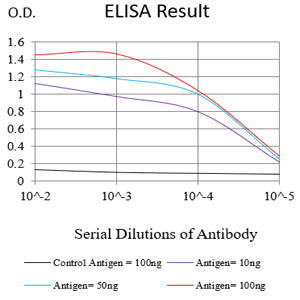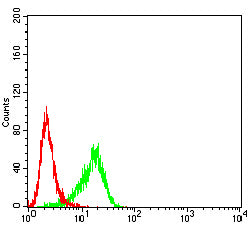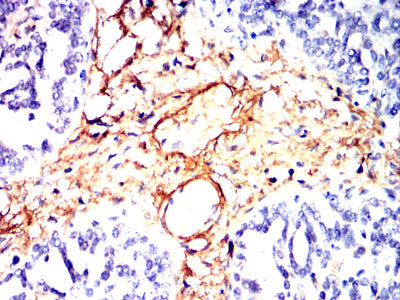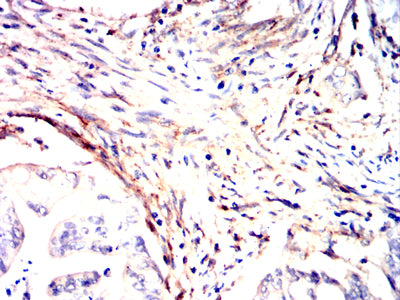



| WB | 咨询技术 | Human,Mouse,Rat |
| IF | 咨询技术 | Human,Mouse,Rat |
| IHC | 1/50-1/300 | Human,Mouse,Rat |
| ICC | 技术咨询 | Human,Mouse,Rat |
| FCM | 咨询技术 | Human,Mouse,Rat |
| Elisa | 1/5000-1/10000 | Human,Mouse,Rat |
| Aliases | AOM; ANFH; SEDC; STL1; COL11A3 |
| Entrez GeneID | 1280 |
| clone | 7F2A11 |
| WB Predicted band size | 142kDa |
| Host/Isotype | Mouse IgG1 |
| Antibody Type | Primary antibody |
| Storage | Store at 4°C short term. Aliquot and store at -20°C long term. Avoid freeze/thaw cycles. |
| Species Reactivity | Human |
| Immunogen | Purified recombinant fragment of human COL2A1 (AA: 1222-1487) expressed in mammalian. |
| Formulation | Purified antibody in PBS with 0.05% sodium azide |
+ +
以下是关于CASK抗体的3篇参考文献,涵盖其在疾病机制和分子功能中的研究应用:
---
1. **文献名称**:*CASK mutations are frequent in male patients with Ohtahara syndrome and X-linked intellectual disability*
**作者**:Saitsu H. et al.
**摘要**:本研究通过基因测序和免疫组化分析,发现CASK基因突变与严重癫痫(如大田原综合征)及X连锁智力障碍相关。研究利用CASK特异性抗体检测患者脑组织样本,发现突变导致CASK蛋白表达显著降低,提示其在大脑早期发育中的关键作用。
---
2. **文献名称**:*CASK regulates the assembly and function of the Mint1/Munc18-1 complex to ensure efficient neurotransmitter release*
**作者**:Atasoy D. et al.
**摘要**:该研究通过免疫沉淀和蛋白质印迹技术(使用CASK抗体),揭示了CASK与突触前蛋白Mint1/Munc18-1复合物的相互作用机制。实验表明CASK通过调控该复合物的组装,影响神经递质释放效率,为突触功能异常相关疾病提供分子机制解释。
---
3. **文献名称**:*CASK stabilizes neurexin and links it to liprin-α in a neuron-specific manner*
**作者**:Mukherjee K. et al.
**摘要**:作者利用CASK抗体进行共聚焦显微镜和免疫印迹实验,证明CASK作为支架蛋白连接神经配体neurexin与脂磷酸酶liprin-α,维持突触后结构稳定性。研究强调了CASK在神经元特异性蛋白互作网络中的枢纽地位。
---
这些文献展示了CASK抗体在基因突变检测、蛋白互作分析及突触功能研究中的关键应用。如需扩展,可进一步检索近年关于CASK在自闭症或癌症中的研究。
The calcium/calmodulin-dependent serine protein kinase (CASP/CAZAK) antibody targets the CASK protein, a multidomain scaffolding molecule critical for synaptic organization, signaling, and neural development. CASK belongs to the membrane-associated guanylate kinase (MAGUK) family, featuring conserved domains (CaMK, PDZ, SH3. GuK) that mediate interactions with neurexins, transcription factors (e.g., TBR1), and cytoskeletal proteins. It plays roles in synaptogenesis, ion channel anchoring, and neurotransmitter release.
CASK dysfunction is linked to neurodevelopmental disorders, including X-linked intellectual disability, microcephaly, and pontocerebellar hypoplasia. Mutations or altered expression may disrupt synaptic plasticity, gene regulation, or brain morphogenesis. Research using CASK antibodies focuses on detecting protein expression/localization in brain tissues, cultured neurons, or patient-derived samples via techniques like Western blot, immunohistochemistry, or immunofluorescence.
However, antibody specificity remains a challenge due to CASK’s structural homology with other MAGUKs. Commercial antibodies vary in reactivity across species (human, mouse, rat) and applications, necessitating validation via knockout controls. Recent studies also explore CASK’s non-neuronal roles in epithelia and cancer, expanding its pathophysiological relevance.
×